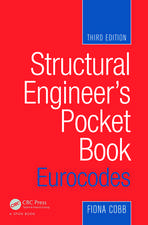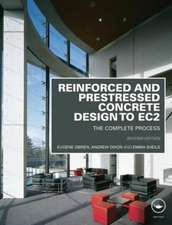Structures or Why things don’t fall down
Editat de J. Gordonen Limba Engleză Paperback – 7 feb 2012
I have to thank a great many people for factual information, suggestions and for stimulating and sometimes heated discussions. Among the living, my colleagues at Reading University have been generous with help, notably Professor W. D. Biggs (Professor of Building Technology), Dr Richard Chaplin, Dr Giorgio Jeronimidis, Dr Julian Vincent and Dr Henry Blyth; Professor Anthony Flew, Professor of Philosophy, made useful suggestions about the last chapter. I am also grateful to Mr John Bartlett, Consultant Neurosurgeon at the Brook Hospital. Professor T. P. Hughes of the University of the West Indies has been helpful about rockets and many other things besides. My secretary, Mrs Jean Collins, was a great help in times of trouble. Mrs Nethercot of Vogue was kind to me about dressmaking. Mr Gerald Leach and also many of the editorial staff of Penguins have exercised their accustomed patience and helpfulness. Among the dead, l owe a great deal to Dr Mark Pryor - lately of Trinity College, Cambridge - especially for discussions about biomechanics which extended over a period of nearly thirty years. Lastly, for reasons which must surely be obvious, l owe a humble oblation to Herodotus, once a citizen of Halicamassus.
Preț: 1005.74 lei
Preț vechi: 1226.52 lei
-18% Nou
Puncte Express: 1509
Preț estimativ în valută:
192.44€ • 200.93$ • 159.27£
192.44€ • 200.93$ • 159.27£
Carte tipărită la comandă
Livrare economică 05-19 aprilie
Preluare comenzi: 021 569.72.76
Specificații
ISBN-13: 9781461590767
ISBN-10: 1461590760
Pagini: 420
Ilustrații: 395 p.
Dimensiuni: 152 x 229 x 22 mm
Greutate: 0.61 kg
Ediția:Softcover reprint of the original 1st ed. 1978
Editura: Springer Us
Colecția Springer
Locul publicării:New York, NY, United States
ISBN-10: 1461590760
Pagini: 420
Ilustrații: 395 p.
Dimensiuni: 152 x 229 x 22 mm
Greutate: 0.61 kg
Ediția:Softcover reprint of the original 1st ed. 1978
Editura: Springer Us
Colecția Springer
Locul publicării:New York, NY, United States
Public țintă
ResearchDescriere
I am very much aware that it is an act of extreme rashness to attempt to write an elementary book about structures. Indeed it is only when the subject is stripped of its mathematics that one begins to realize how difficult it is to pin down and describe those structural concepts which are often called' elementary'; by which I suppose we mean 'basic' or 'fundamental'. Some of the omis sions and oversimplifications are intentional but no doubt some of them are due to my own brute ignorance and lack of under standing of the subject. Although this volume is more or less a sequel to The New Science of Strong Materials it can be read as an entirely separate book in its own right. For this reason a certain amount of repeti tion has been unavoidable in the earlier chapters. I have to thank a great many people for factual information, suggestions and for stimulating and sometimes heated discussions. Among the living, my colleagues at Reading University have been generous with help, notably Professor W. D. Biggs (Professor of Building Technology), Dr Richard Chaplin, Dr Giorgio Jeronimidis, Dr Julian Vincent and Dr Henry Blyth; Professor Anthony Flew, Professor of Philosophy, made useful suggestions about the last chapter. I am also grateful to Mr John Bartlett, Consultant Neurosurgeon at the Brook Hospital. Professor T. P.
Cuprins
1 The structures in our lives — or how to communicate with engineers.- One The difficult birth of the science of elasticity.- 2 Why structures carry loads — or the springiness of solids.- 3 The invention of stress and strain — or Baron Cauchy and the decipherment of Young’s modulus.- 4 Designing for safety — or can you really trust strength calculations?.- 5 Strain energy and modem fracture mechanics — with a digression on bows, catapults and kangaroos.- Two Tension structures.- 6 Tension structures and pressure vessels — with some remarks on boilers, bats and Chinese junks.- 7 Joints, fastenings and people — also about creep and chariot wheels.- 8 Soft materials and living structures — or how to design a worm.- Three Compression and bending structures.- 9 Walls, arches and dams — or cloud-capp’d towers and the stability of masonry.- 10 Something about bridges — or Saint Bénezèt and Saint Isambard.- 11 The advantage of being a beam — with observations on roofs, trusses and masts.- 12 The mysteries of shear and torsion — or Polaris and the bias-cut nightie.- 13 The various ways of failing in compression — or sandwiches, skulls and Dr Euler.- Four And the consequence was….- 14 The philosophy of design — or the shape, the weight and the cost.- 15 A chapter of accidents — a study in sin, error and metal fatigue.- 16 Efficiency and aesthetics — or the world we have to live in.- Appendix 1 Handbooks and formulae.- Appendix 2 Beam theory.- Appendix 3 Torsion.- Appendix 4 The efficiency of columns and panels under compression loads.- Suggestions for further study.








